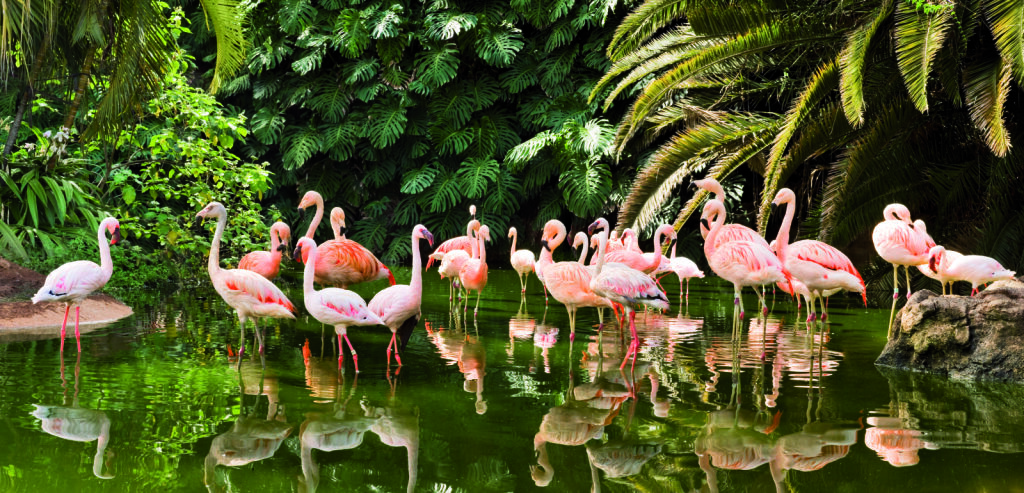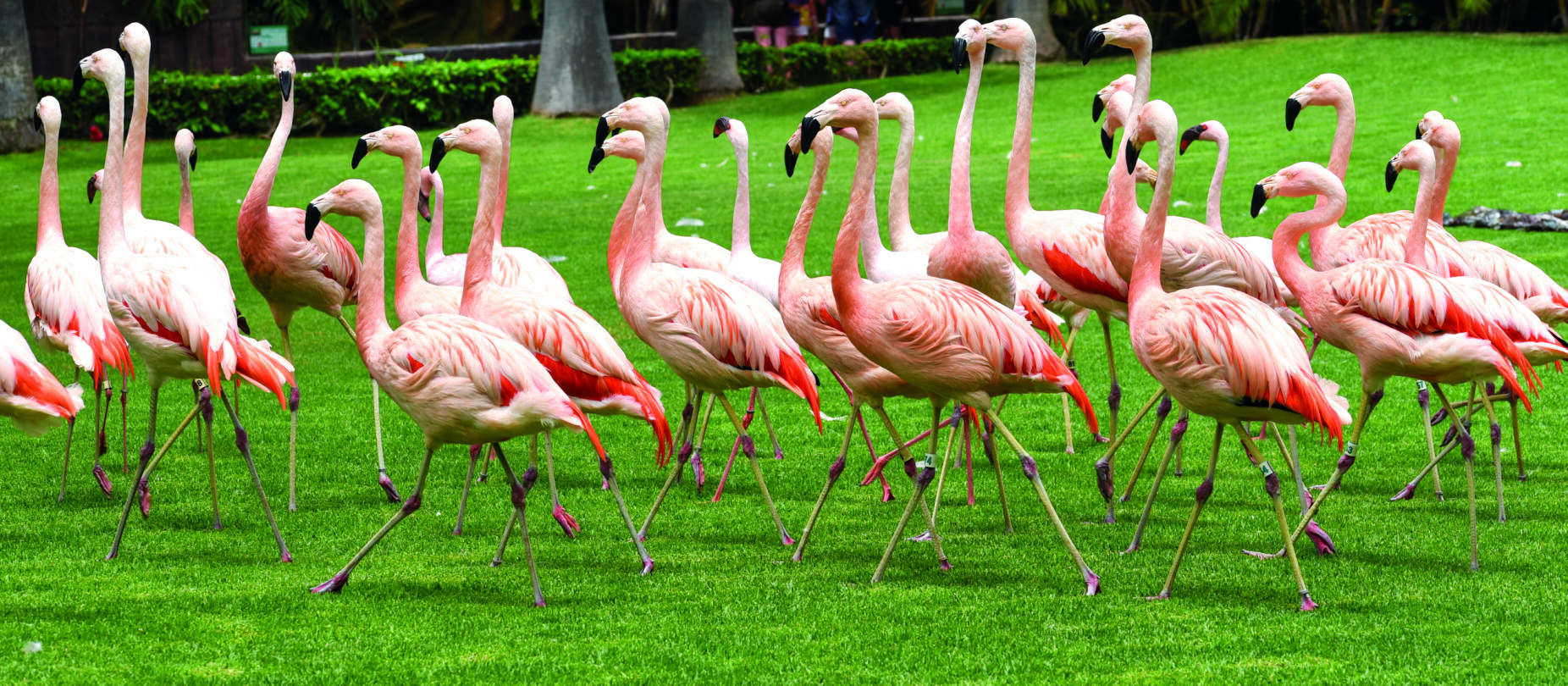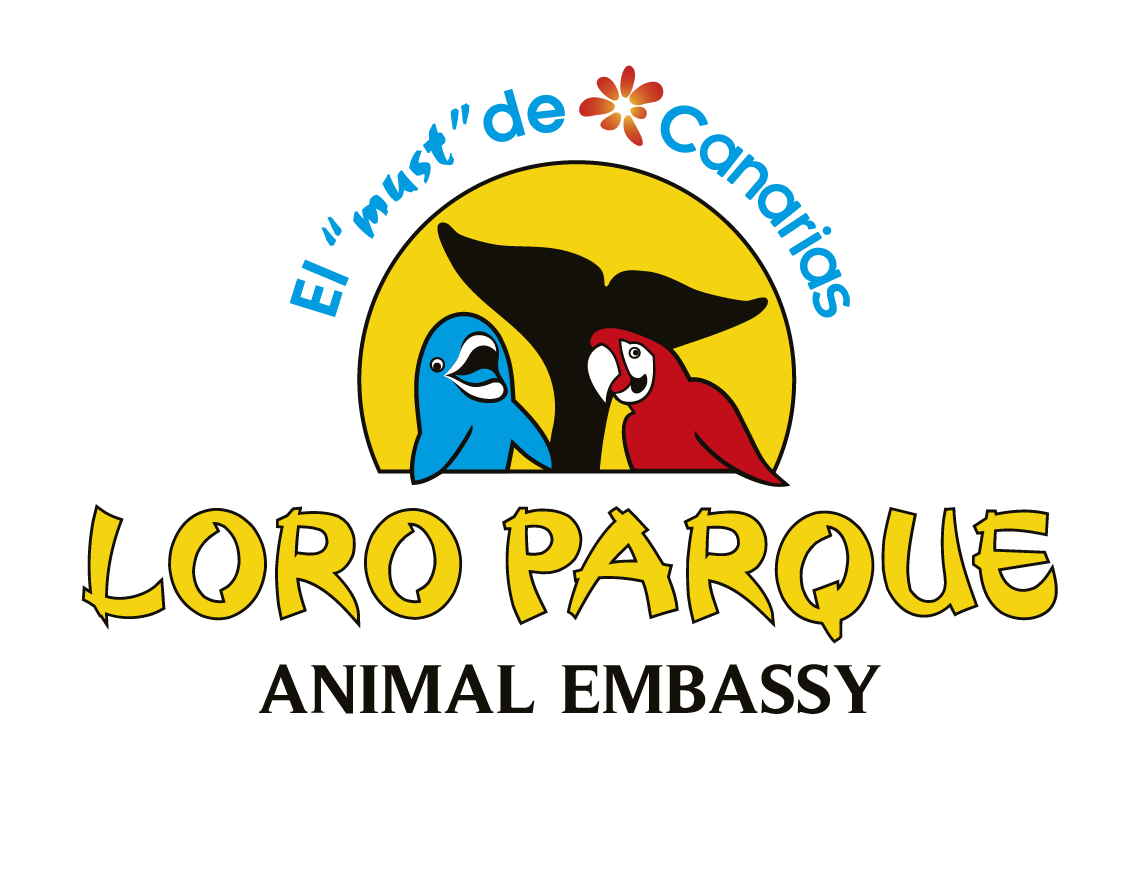Flamingos are a type of bird with unrivalled beauty. These animals stand out for their long legs, elegant gait, and pink hues, which are linked to their diet. For many lovers of these birds, simply seeing them in photos or videos is not enough, as nothing compares to admiring them in person and learning more about them.
For example, have you ever wondered why they are pink, where they live, or what species of flamingo exist? Today, at Loro Parque, we will answer these and other questions to learn first-hand all about these fascinating birds.

Characteristics of flamingos: why they are unique
Flamingos are birds with webbed feet, belonging to the family Phoenicopteridae. They are slender, with very long necks and legs, and their distinctive plumage can range from pale pink to an almost red-pink hue.
They also have a downward-curved bill, with the upper jaw more developed than the lower one, allowing them to filter food efficiently from the water.
In terms of size, flamingos stand between 0.80 metres and 1.50 metres tall, which makes them slender and easily recognisable.
Despite this considerable height, their weight remains relatively light, between 2 kg and 4 kg in fully grown adults.
As with other web-footed birds, sexual dimorphism is present: males are usually larger than females.

Types of flamingos: up to 6 species
Although they may look similar at first glance, there are actually several species of flamingos, distinguished mainly by colour, size, and the type of food they filter from the water. Smaller flamingos feed on tiny organisms, while larger ones capture bigger prey such as molluscs and crustaceans.
Generally, flamingos are found in similar environments (lakes, salt flats, and coastal areas), and their diets vary according to their size.
We can divide flamingo species into two major groups
- Small flamingos (Phoenicoparrus and Phoeniconaias)
- Andean flamingo (Phoenicoparrus andinus)
- James’s flamingo (Phoenicoparrus jamesi)
- Lesser flamingo (Phoeniconaias minor)
- Large flamingos (Phoenicopterus)
- Chilean flamingo (Phoenicopterus chilensis)
- Greater or African flamingo (Phoenicopterus roseus)
- Caribbean or American flamingo (Phoenicopterus ruber)
At Loro Parque, we house African flamingos, the most common and largest flamingo species. They are often confused with Caribbean flamingos, as both are sometimes grouped under the name “pink flamingos.” However, they differ in distribution and colour: the Greater or African flamingo lives in Asia, North Africa, and southern Europe and tends to have paler plumage, while the Caribbean flamingo is native to tropical regions of the Americas and displays a deeper pink hue. In addition, we also have Chilean and Lesser flamingos.

Where do flamingos live?
Flamingos are fascinating and surprising animals. Their natural habitats are swamps, marshes, lakes, and saltwater lagoons, mainly located in warm and humid climates.
For example, in Mexico, Caribbean flamingos can be found in Las Coloradas, part of the Ría Lagartos Biosphere Reserve, as well as in Central America and some tropical regions of South America.
Remarkably, some flamingos thrive in unexpected environments such as Lake Natron in Tanzania, one of the harshest environments on Earth, where the water’s pH equals that of household bleach. Yet, it is one of the preferred breeding sites of the Greater flamingo.
In Andalusia, the Fuente de Piedra lagoon is home to the second largest flamingo colony in Europa.
Flamingo reproduction
Flamingos typically live in flocks. These may consist of dozens or even thousands of individuals; in some regions of Africa, colonies of up to one million flamingos have been recorded, guided by a leader that decides where to move and feed.
Like many bird species, flamingos nest in colonies, laying their eggs on mud mounds that they build themselves. Their reproduction is a remarkable natural spectacle:
- When one female enters breeding season, other females in the flock typically become receptive at the same time.
- Flamingos are usually monogamous: once paired, they stay together for life unless one partner dies or the couple fails to produce offspring.
- Their courtship ritual includes stretching their necks, flapping their wings, and calling loudly to attract attention.
- Once a female accepts a mate, the male continues courting until she is ready to copulate.
- After mating, the male stays with the female to help build the nest.
- Once the chick hatches, it is fed with “crop milk”, a secretion rich in protein and fat produced by both parents.
Flamingo diet
To feed, flamingos submerge their heads and necks and use their bills as shovels. They scoop up water, expel it, and use their tongue to filter out whatever they have caught.
Their diet includes crustaceans, algae, and other small organisms found in marshes and wetlands.
Fascinatingly, their pink colouration is directly linked to their diet: the crustaceans, invertebrates, and algae they consume are rich in carotenoids, a red-orange pigment (the same that colours carrots and tomatoes).
As they ingest it, the pigment accumulates in their feathers, giving them their characteristic rosy hue.
Flamingos and conservation
While the Greater and Caribbean flamingos are not currently endangered, other species are classified as near-threatened or vulnerable.
According to CITES (the Convention on International Trade in Endangered Species of Wild Fauna and Flora), flamingos require specific levels of protection and regulation to prevent population decline.
At Loro Parque, we are committed to creating breeding and conservation spaces for flamingos. These safe and protected environments play an essential role in preserving and understanding such a unique species.
Finally, we encourage you to visit our grounds and admire our African, Chilean, and Lesser flamingos in their habitat. It will undoubtedly be a memorable experience to enjoy with the whole family.











